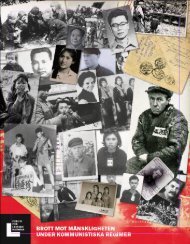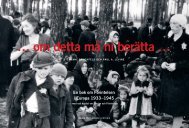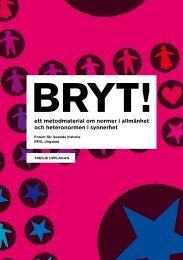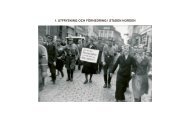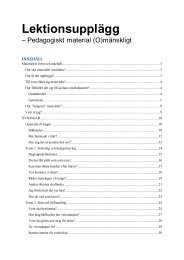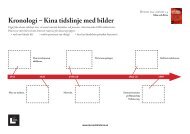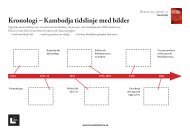Children…
Tell Ye Your Children... - Levandehistoria.se
Tell Ye Your Children... - Levandehistoria.se
- No tags were found...
Create successful ePaper yourself
Turn your PDF publications into a flip-book with our unique Google optimized e-Paper software.
“All through that winter small children, stark<br />
naked and barefooted, had to stand out in the<br />
open for hours on end, awaiting their turn in<br />
the increasingly busy gas chambers. The soles of<br />
their feet froze and stuck to the icy ground. They<br />
stood and cried; some of them froze to death.<br />
In the meantime, Germans and Ukrainians<br />
walked up and down the ranks, beating and<br />
kicking the victims.<br />
One of the Germans, a man named Sepp,<br />
was a vile and savage beast, who took special<br />
delight in torturing children. When he pushed<br />
women around and they begged him to stop<br />
because they had children with them, he would<br />
frequently snatch the child from the woman’s<br />
arms and either tear the child in half or grab it<br />
by the legs, smash its head against a wall and<br />
throw the body away.”<br />
YANKEL WIERNIK, TREBLINKA SURVIVOR<br />
Operation Reinhardt<br />
Between March 1942 and October 1943, at least 1.5 million<br />
people were murdered at the Belzec, Sobibor and Treblinka<br />
death camps.These camps were part of “Operation<br />
Reinhardt”, which sought to empty Poland of its Jews and<br />
seize their possessions. Nothing was to be wasted. Aside<br />
from clothes, money and personal effects, even hair and<br />
gold dental fillings were plundered. This work, and the<br />
clearing of the corpses, was carried out by Jewish prisoners.<br />
The three camps were small, about 600 metres<br />
long and some 400 metres wide, and were constructed<br />
according to similar principles. Few Germans were at<br />
each camp: the staff usually comprised about 30 SS<br />
soldiers, aided by some 100 Ukrainian and Baltic auxiliaries.<br />
Treblinka, a former SS man stationed there said,<br />
was “a primitive but efficient production line of death”.<br />
In those camps, unlike in Auschwitz and Majdanek, no<br />
doctors “selected” victims when they arrived, usually<br />
in packed freight cars. The Jews were told that they<br />
had come to work, but that they must first undress for<br />
“disinfection” and leave all their possessions. Men went<br />
to one side and women and children to the other. Then<br />
they were separately herded into the gas chambers.<br />
The engines started and pipes introduced exhaust<br />
fumes into the tightly packed chambers.The entire process<br />
was over in an hour or two.At Treblinka,up to 15,000<br />
people could be murdered in one day, but, the same SS<br />
man explained, they “had to spend half the night at it”.<br />
Initially, bodies were buried in enormous mass graves,<br />
but from autumn 1942, the Germans burned them. At<br />
most, a hundred Jews survived Treblinka, fewer than<br />
fifty survived Sobibor, and Belzec, only two.<br />
72



